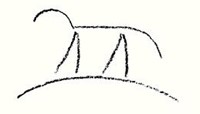Observing the animal form – Reading 4
“Consider then the skeleton of an animal. I will go no farther than the skeleton, but what I say of this is true in an even higher degree of the other parts and systems in the human and animal body. Look at the obvious differentiation, comparing the skull with the opposite end of the animal. If you do this with morphological insight, you will perceive characteristic harmonies or agreements, and also characteristic diversities. Here is a line of research which should be followed in far greater detail. Here is something to be seen and recognized, which will lead far more deeply into realty than scientists today are wont to go.
It lies in the very nature of these lectures that I can only hint at such things, leaving out many an intervening link. I must appeal to your own intuition, trusting you to think it out and fill in what is missing between one lecture and the next. You will then see how all these things are connected. If I did otherwise in these few lectures, we should not reach the desired end.
 Diagrammatically now (Fig. 1), let this be the animal form. If after going into an untold number of intervening links in the investigation, you put the question: ‘What is the characteristic difference of the front and the back, the head and the tail end due to?’, you will reach a very interesting conclusion. Namely you will connect the differentiation of the front end with the influences of the Sun. Here is the Earth (Fig. 2). You have an animal on the side of the Earth exposed to the Sun. Now take the side of the Earth that is turned away from the Sun. In one way or another it will come about that the animal is on this other side. Here too the Sun’s rays will be influencing the animal, but the earth is now between. In the one case the rays of the Sun are working on the animal directly; in the other case indirectly, inasmuch as the Earth is between and the Sun’s rays first have to pass through the Earth (Fig.2).
Diagrammatically now (Fig. 1), let this be the animal form. If after going into an untold number of intervening links in the investigation, you put the question: ‘What is the characteristic difference of the front and the back, the head and the tail end due to?’, you will reach a very interesting conclusion. Namely you will connect the differentiation of the front end with the influences of the Sun. Here is the Earth (Fig. 2). You have an animal on the side of the Earth exposed to the Sun. Now take the side of the Earth that is turned away from the Sun. In one way or another it will come about that the animal is on this other side. Here too the Sun’s rays will be influencing the animal, but the earth is now between. In the one case the rays of the Sun are working on the animal directly; in the other case indirectly, inasmuch as the Earth is between and the Sun’s rays first have to pass through the Earth (Fig.2).
 Expose the animal form to the direct influence of the Sun and you get the head. Expose the animal to those rays of the Sun which have first gone through the Earth and you get the opposite pole to the head. Study the skull, so as to recognize in it the direct outcome of the influences of the Sun. Study the forms, the whole morphology of the opposite pole, so as to recognize the working of the Sun’s rays before which the Earth is interposed — the indirect rays of the Sun. Thus the morphology of the animal itself draws our attention to a certain interrelation between Earth and Sun. For a true knowledge of the mutual relations of Earth and Sun we must create the requisite conditions, not by the mere visual appearance (even though the eye be armed with telescopes), but by perceiving also how the animal is formed — how the whole animal form comes into being.”
Expose the animal form to the direct influence of the Sun and you get the head. Expose the animal to those rays of the Sun which have first gone through the Earth and you get the opposite pole to the head. Study the skull, so as to recognize in it the direct outcome of the influences of the Sun. Study the forms, the whole morphology of the opposite pole, so as to recognize the working of the Sun’s rays before which the Earth is interposed — the indirect rays of the Sun. Thus the morphology of the animal itself draws our attention to a certain interrelation between Earth and Sun. For a true knowledge of the mutual relations of Earth and Sun we must create the requisite conditions, not by the mere visual appearance (even though the eye be armed with telescopes), but by perceiving also how the animal is formed — how the whole animal form comes into being.”
R. Steiner, Third Scientific Lecture Course – Astronomy Lecture 7, 7 January 1921, CW323